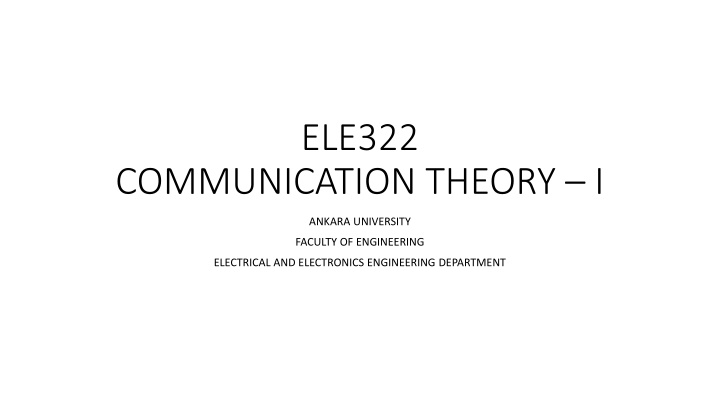
Communication Systems in Electrical Engineering
Explore the fundamentals of communication systems in Electrical Engineering at Ankara University. Learn about analog and digital messages, elements of communication systems, signal contamination effects, fundamental limitations, and the importance of modulation in efficient transmission.
Download Presentation

Please find below an Image/Link to download the presentation.
The content on the website is provided AS IS for your information and personal use only. It may not be sold, licensed, or shared on other websites without obtaining consent from the author. If you encounter any issues during the download, it is possible that the publisher has removed the file from their server.
You are allowed to download the files provided on this website for personal or commercial use, subject to the condition that they are used lawfully. All files are the property of their respective owners.
The content on the website is provided AS IS for your information and personal use only. It may not be sold, licensed, or shared on other websites without obtaining consent from the author.
E N D
Presentation Transcript
ELE322 COMMUNICATION THEORY I ANKARA UNIVERSITY FACULTY OF ENGINEERING ELECTRICAL AND ELECTRONICS ENGINEERING DEPARTMENT
ELE322 COMMUNICATION THEORY - I LECTURE 1 INTRODUCTION TO COMMUNICATION SYSTEMS Ankara University, Electrical and Electronics Engineering Department, ELE322 Communication Theory I
Communication system with input and output transducers (Fig.1.1-1 Carlson, page 3) Information (message) transfer Analog messages: degree of fidelity in analog communication systems Digital messages: degree of accuracy in digital communication systems Ankara University, Electrical and Electronics Engineering Department, ELE322 Communication Theory I
Elements of a communication system (Fig.1.1-2 Carlson, page 4) Transmitter: modulation, source coding, channel coding Transmission channel: loss (attenuation), noise, interference distortion Receiver: demodulation, source decoding, channel decoding Ankara University, Electrical and Electronics Engineering Department, ELE322 Communication Theory I
Contamination of a signal transmitting a 1101001 sequence (a) original signal as it leaves the transmitter (b) effects of distortion (c) effects of interference (d) effects of noise (Fig.1.1-3 Carlson, page 5) Unwanted (corrupting) effects: Noise Interference Distortion Ankara University, Electrical and Electronics Engineering Department, ELE322 Communication Theory I
Fundamental limitations Technological problems Fundamental pyhsical limitations: Bandwidth Noise Shannon (1948) stated that the rate of information transmission can not exceed the channel capacity (Hartley-Shannon Law): ? = ?log2 1 +? ? = 3.32?log10(1 +? ?) Ankara University, Electrical and Electronics Engineering Department, ELE322 Communication Theory I
Modulation Modulation is defined as the process by which some characteristic of a carrier wave is varied in accordance with an information bearing signal (also called message signal) (Haykin, page 100). Modulation benefits: Efficient transmission (reduces antenna dimensions) Overcome hardware limitations Reduce noise and interference Frequency assignment Multiplexing Ankara University, Electrical and Electronics Engineering Department, ELE322 Communication Theory I
References Communication Systems, An Introduction to Signal and Noise in Electrical Communication, 5th edition, A.B. Carlson, P.B. Crilly, J.C. Rutledge, Mc Graw Hill. An Introduction to Analog and Digital Communications, 2nd edition, S. Haykin, M. Moher, Wiley. Ankara University, Electrical and Electronics Engineering Department, ELE322 Communication Theory I
